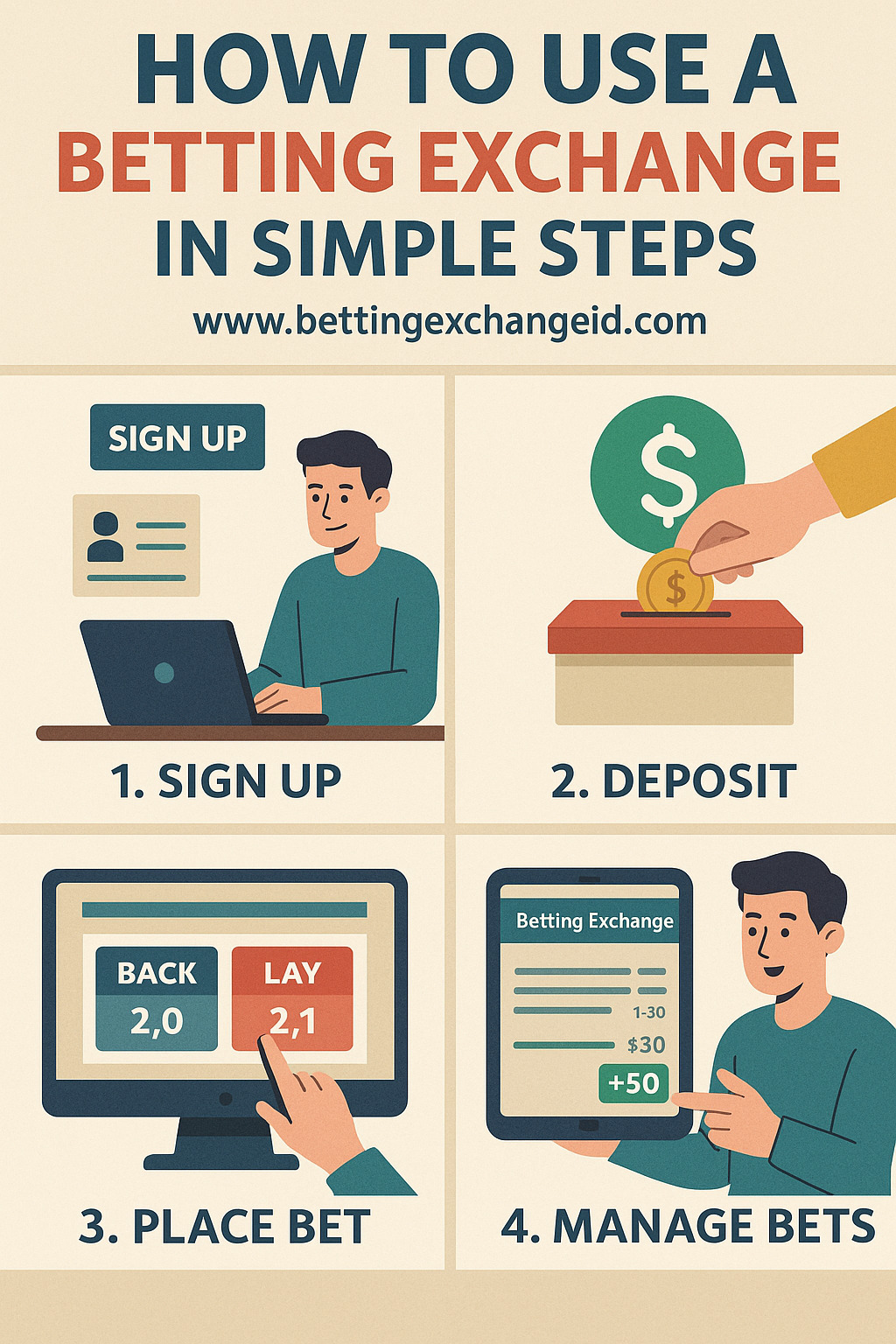
Betting exchanges are revolutionizing the online gambling industry, offering a fresh alternative to traditional sportsbooks. Unlike a bookmaker where you bet against the house, betting exchanges allow users to bet against each other. This not only opens up new strategies but also provides better odds, more transparency, and a higher level of control. In this detailed guide, we walk you through how to use a betting exchange in simple steps, ensuring a seamless experience whether you’re a novice or a seasoned punter.
What is a Betting Exchange and How Does it Work?
A betting exchange is an online platform where users can place bets against each other, rather than against a bookmaker. There are two main types of bets on a betting exchange:
-
Back Bets – You bet on something to happen (e.g., a team to win).
-
Lay Bets – You bet on something not to happen (e.g., a team not to win).
This dynamic allows users to act as both the bettor and the bookmaker.
Step 1: Choose a Reliable Betting Exchange Platform
Before getting started, you must choose a reputable platform. Popular betting exchange sites include:
-
Betfair Exchange
-
Smarkets
-
Betdaq
-
Matchbook
Look for platforms that offer competitive commission rates, high liquidity, a user-friendly interface, and strong customer support.
Step 2: Create and Verify Your Account
After selecting a platform:
-
Sign up using your personal details.
-
Verify your identity (usually with ID and address proof) to comply with regulatory requirements.
-
Set up payment methods such as credit/debit cards, e-wallets, or bank transfers.
-
Fund your account with a deposit to start placing bets.
Step 3: Understand the Back and Lay Betting Concept
Mastering the difference between backing and laying is crucial:
-
Backing is the traditional form of betting. You bet for a selection to win.
-
Laying is offering a bet to someone else, meaning you bet against a selection winning.
For example, if you lay a football team, you are betting that the team will lose or draw – any outcome other than a win.
Step 4: Learn to Read the Betting Exchange Interface
The layout of a betting exchange differs from traditional sportsbooks:
-
Blue boxes usually represent back prices.
-
Pink boxes represent lay prices.
-
The figures inside show the odds.
-
Below the odds, you’ll often see the available amount to bet at those odds.
Take time to familiarize yourself with the layout to place informed and accurate bets.
Step 5: Place a Back Bet
To place a back bet:
-
Navigate to your preferred market (e.g., football, tennis, horse racing).
-
Select the blue box with the odds you find favorable.
-
Enter your stake amount.
-
Confirm and place the bet.
If the event goes your way, your profit is calculated as:
(Odds – 1) × Stake
Example: You bet $10 at odds of 4.0. Your profit will be:
(4.0 – 1) × $10 = $30
Step 6: Place a Lay Bet
To place a lay bet:
-
Click the pink box next to the selection you believe will not win.
-
Enter the liability amount – this is what you risk losing if the event doesn’t go your way.
-
Confirm your lay bet.
Lay bets require a good grasp of risk. For example, if you lay $10 at odds of 3.0, your liability is:
(3.0 – 1) × $10 = $20
So if your selection wins, you lose $20. If it doesn’t, you win the $10 stake.
Step 7: Use the Exchange Market Features to Your Advantage
Top betting exchanges offer features that can enhance your betting experience:
-
In-play betting – Bet during the event for dynamic odds.
-
Cash-out options – Secure profits or cut losses before the event ends.
-
Price matching – Wait for better odds to become available before your bet is matched.
-
Market depth – Shows how much money is waiting at each price point, indicating liquidity.
Understanding and utilizing these features can greatly improve your profitability.
Step 8: Keep Track of Your Bets and Profits
A disciplined approach is essential for long-term success on betting exchanges:
-
Use spreadsheets or dedicated bet tracking software to monitor your performance.
-
Keep a bankroll management system in place to avoid reckless betting.
-
Regularly review your strategies to identify strengths and weaknesses.
Consistency and data-driven decisions separate successful traders from casual punters.
Step 9: Consider Using Betting Exchange Software Tools
For advanced users, specialized software can elevate your experience:
-
Trading bots for automated strategies.
-
Odds comparison tools to find the best market prices.
-
Live stats integration for real-time data during in-play betting.
These tools are particularly helpful for arbitrage, scalping, and matched betting techniques.
Step 10: Be Aware of Commission and Fees
Most betting exchanges charge a commission on net winnings, typically between 2% to 5%. It’s important to factor in these fees when calculating potential profits. Some platforms offer loyalty discounts or VIP tiers, so consistent betting can lead to lower fees over time.
Common Mistakes to Avoid When Using a Betting Exchange
-
Not understanding liability: Especially with lay betting, failure to calculate liability can lead to large losses.
-
Ignoring liquidity: Low liquidity can prevent bets from being matched or limit your stake size.
-
Chasing losses: Emotional betting often leads to poor decisions.
-
Lack of strategy: Random betting without analysis rarely ends profitably.
Always bet with a clear, reasoned approach and a full understanding of how the exchange works.
Conclusion: Embrace the Power of Betting Exchanges
Using a betting exchange effectively requires a mix of strategic thinking, financial discipline, and a strong understanding of the mechanics. From placing back and lay bets to leveraging in-play options and advanced software, betting exchanges open up a world of opportunity for smart bettors. Start with small stakes, test your strategies, and grow your expertise steadily.
